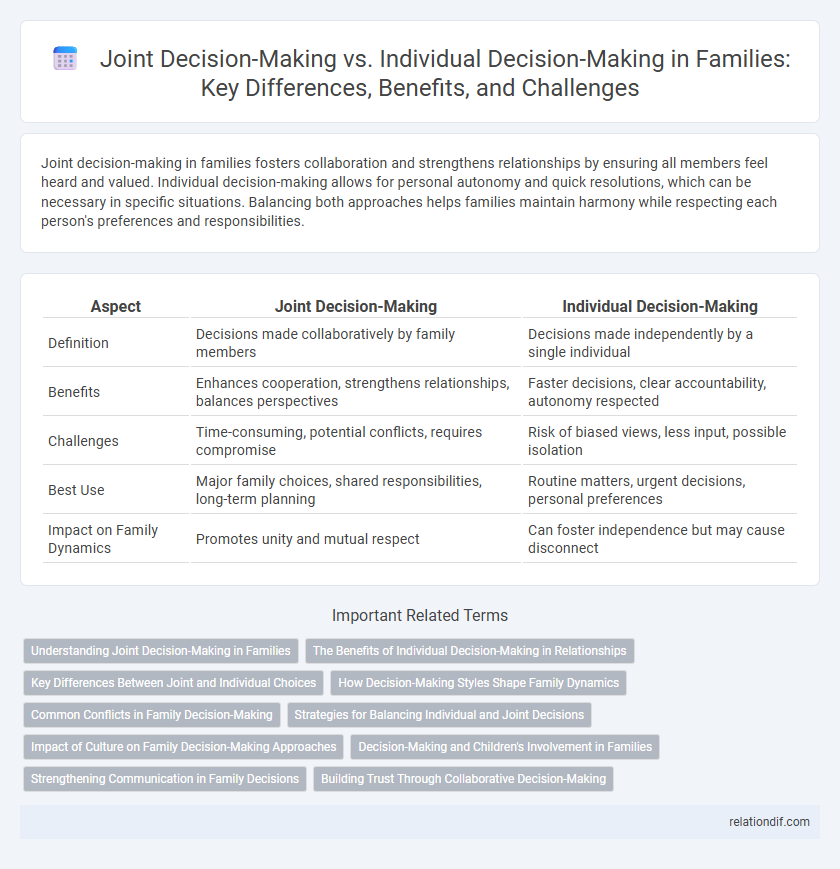Joint decision-making in families fosters collaboration and strengthens relationships by ensuring all members feel heard and valued. Individual decision-making allows for personal autonomy and quick resolutions, which can be necessary in specific situations. Balancing both approaches helps families maintain harmony while respecting each person's preferences and responsibilities.
Table of Comparison
| Aspect | Joint Decision-Making | Individual Decision-Making |
|---|---|---|
| Definition | Decisions made collaboratively by family members | Decisions made independently by a single individual |
| Benefits | Enhances cooperation, strengthens relationships, balances perspectives | Faster decisions, clear accountability, autonomy respected |
| Challenges | Time-consuming, potential conflicts, requires compromise | Risk of biased views, less input, possible isolation |
| Best Use | Major family choices, shared responsibilities, long-term planning | Routine matters, urgent decisions, personal preferences |
| Impact on Family Dynamics | Promotes unity and mutual respect | Can foster independence but may cause disconnect |
Understanding Joint Decision-Making in Families
Joint decision-making in families involves collaborative discussions where members share perspectives, negotiate priorities, and reach consensus to address household matters or significant life choices. This process enhances communication skills, strengthens relationships, and fosters a sense of shared responsibility among family members. Effective joint decision-making balances individual preferences with collective goals, promoting harmony and cooperative problem-solving within the family unit.
The Benefits of Individual Decision-Making in Relationships
Individual decision-making in relationships fosters personal growth by allowing each partner to develop independence and self-confidence. It encourages clear communication and respect for boundaries, reducing conflicts arising from pressure to conform. Empowering individuals to make their own choices contributes to a balanced partnership where both voices are valued.
Key Differences Between Joint and Individual Choices
Joint decision-making in families involves collaborative discussion, balancing diverse perspectives to reach a consensus, while individual decision-making relies on a single person's judgment and preferences. Joint choices often strengthen relationships and improve satisfaction by incorporating multiple viewpoints, whereas individual decisions can be faster but may risk overlooking important factors. Key differences include the level of communication, shared responsibility, and the impact on family dynamics and cohesion.
How Decision-Making Styles Shape Family Dynamics
Joint decision-making fosters collaboration and strengthens family bonds by promoting shared responsibility and mutual understanding, which enhances communication and trust among members. Individual decision-making often leads to quicker choices but may create power imbalances or feelings of exclusion, potentially causing tension or reduced cohesion in the family unit. Families that balance both styles tend to develop adaptive dynamics, ensuring personal autonomy while maintaining collective harmony.
Common Conflicts in Family Decision-Making
Joint decision-making in families often leads to conflicts rooted in differing priorities, communication styles, and individual values, which can cause misunderstandings and tension. Individual decision-making may reduce immediate disputes but risks alienating members and fostering resentment due to perceived exclusion from important choices. Balancing these approaches requires clear communication and mutual respect to address conflicts effectively and maintain family harmony.
Strategies for Balancing Individual and Joint Decisions
Effective strategies for balancing individual and joint decision-making in families include establishing clear communication channels and setting boundaries that respect personal autonomy while promoting collaboration. Utilizing scheduled family meetings to discuss major issues allows each member to contribute input, fostering mutual understanding and consensus. Implementing decision-making frameworks, such as prioritizing decisions based on their impact scope--joint for significant family matters and individual for personal choices--enhances harmony and respects diversity within the family unit.
Impact of Culture on Family Decision-Making Approaches
Cultural values significantly influence whether families prefer joint or individual decision-making, with collectivist cultures typically emphasizing group consensus to maintain harmony and individualist cultures prioritizing personal autonomy. In collectivist societies such as those in East Asia, joint decision-making fosters strong family bonds and shared responsibility, enhancing familial cohesion and support. Conversely, in Western cultures where individualism prevails, decisions often reflect personal preferences, promoting independence but sometimes reducing collective family involvement.
Decision-Making and Children's Involvement in Families
Joint decision-making in families fosters children's active involvement, promoting critical thinking and emotional intelligence by encouraging collaboration and shared responsibility. Individual decision-making often limits children's participation, which may hinder their development of problem-solving skills and reduce their sense of agency within the family unit. Research indicates that involving children in family decisions enhances communication, strengthens relationships, and supports positive behavioral outcomes.
Strengthening Communication in Family Decisions
Joint decision-making in families fosters open communication, promoting trust and mutual understanding among members. Collaborative discussions enhance problem-solving skills and ensure that diverse perspectives are considered, leading to more satisfying outcomes. Prioritizing shared inputs strengthens emotional bonds and supports a cohesive family environment.
Building Trust Through Collaborative Decision-Making
Collaborative decision-making in families fosters trust by encouraging open communication and shared responsibility among members, enhancing emotional bonds and mutual respect. Joint decisions create a supportive environment where each member feels valued and heard, promoting transparency and reducing conflicts. This trust-building approach strengthens family unity and resilience by aligning goals and ensuring everyone's perspectives contribute to important choices.
Joint decision-making vs Individual decision-making Infographic

 relationdif.com
relationdif.com